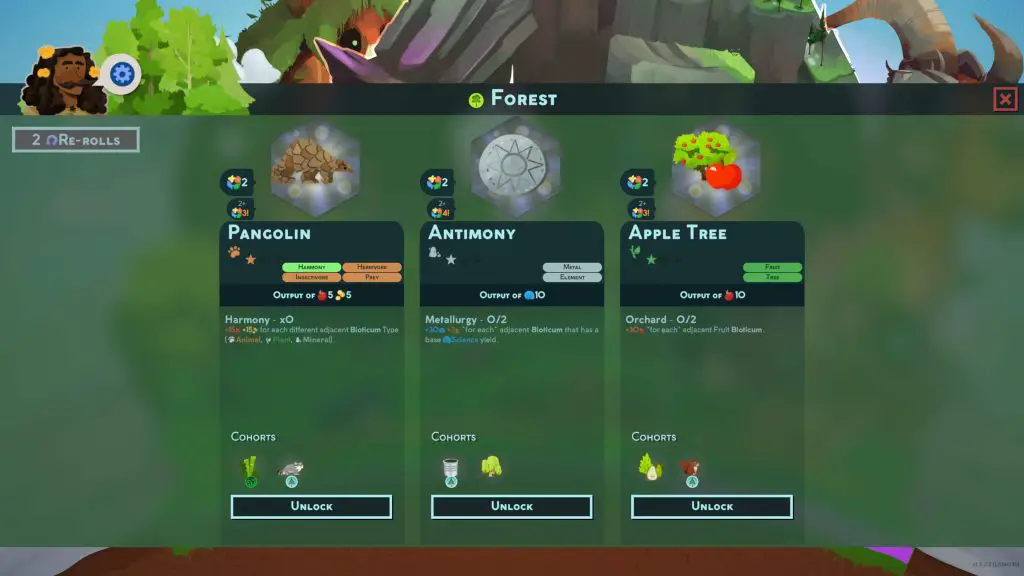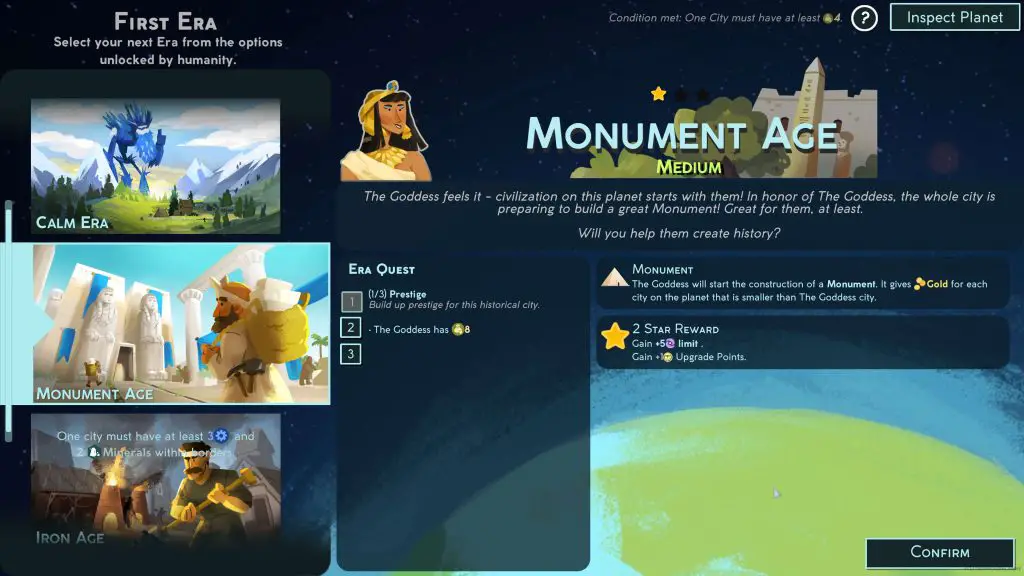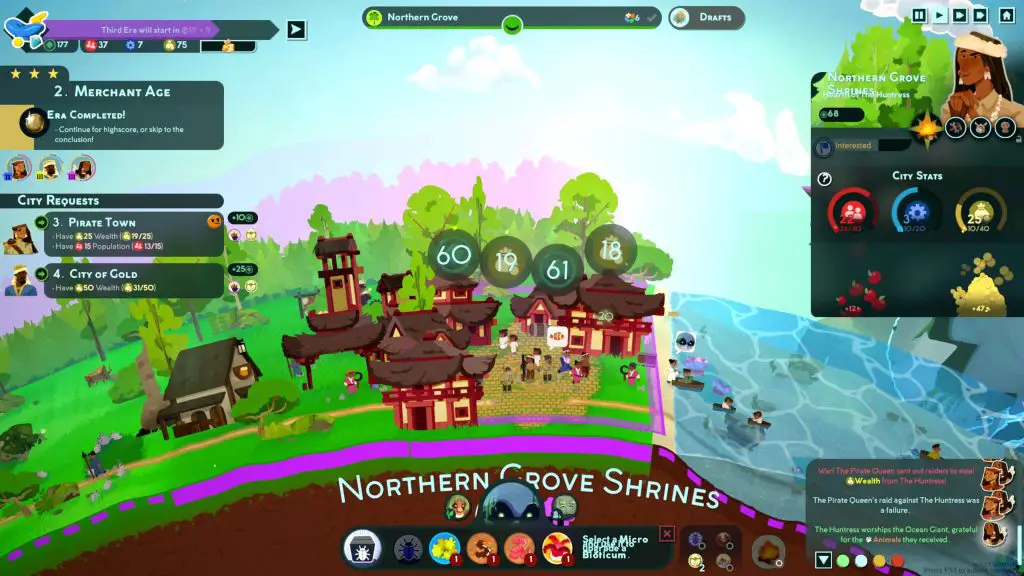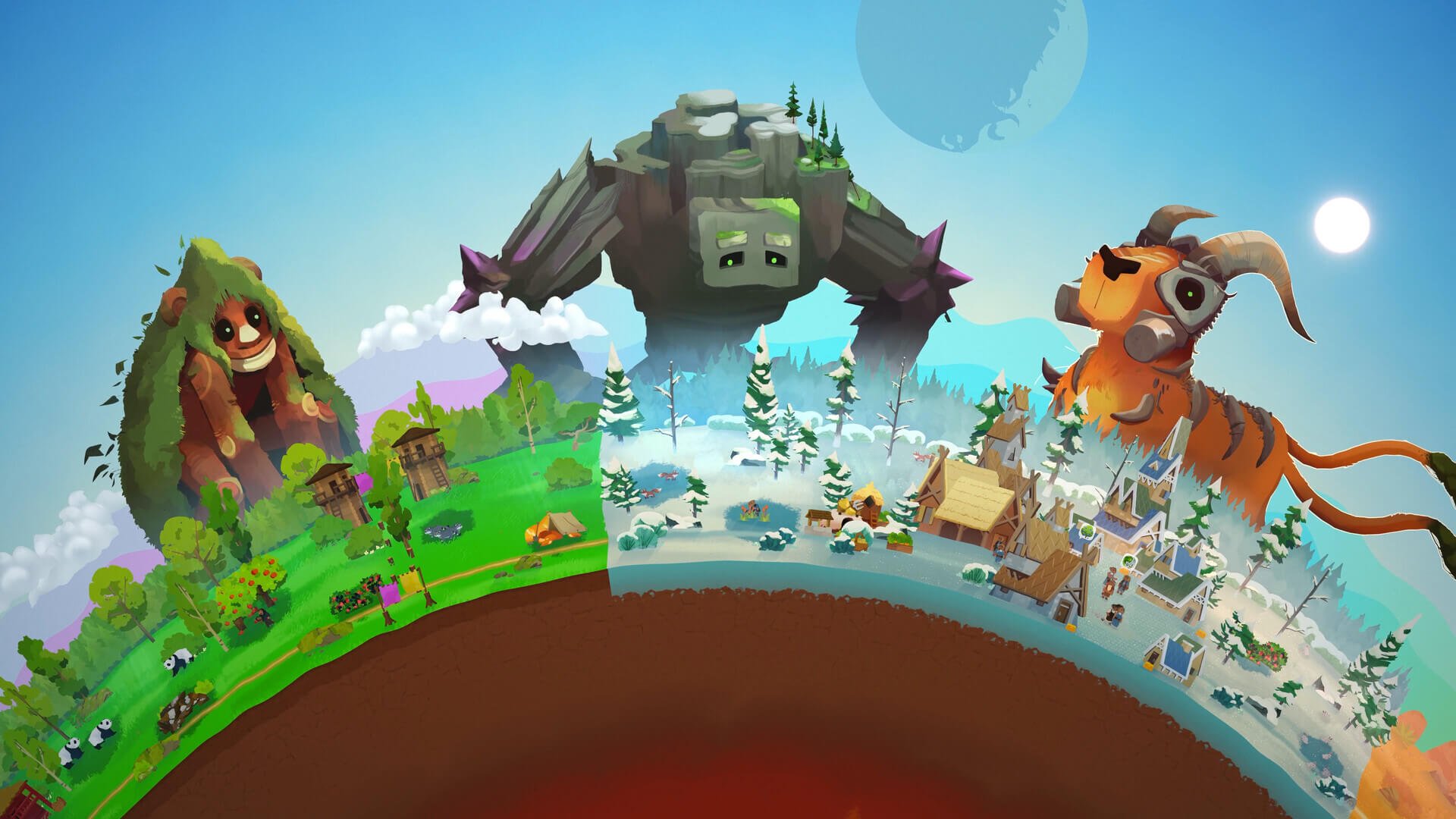This is a review I never thought I would write… mainly because when I purchased Abbey Games’ most recent title, Reus 2, I didn’t realize the series had adopted a new turn-based form. My assumption was based on playing the original title almost 10 years ago (a very sobering thought) when it appeared in one of the very first Humble Bundles, and I remember being charmed at first glance by its colorful gods and cozy feeling.
This was until I played through a few sessions and realized what the original Reus ACTUALLY was: a cutthroat race against the clock to piece together a rather tricky puzzle and max out your planet’s efficiency before the countdown erased it from existence.
In developing a sequel, the developers must have realized the tonal contradiction in the original and decided that Reus 2 would lean far more into the cozy. Your godly giants no longer beat the planet into a misshapen pulp (not as much of one, anyway), and there is no counting timer looming over your head at every moment.
What we have instead is a variety of flora and fauna that would put a Zoo Tycoon game to shame and an energy based turn system allowing the player to think for as long as they need but still punish too many inefficient plays.
Building Your Planet
Let’s take a step back; I’m getting ahead of myself. For those who may not know this series, what actually is Reus? Well, from the outside, it portrays itself as a god game. Take control of three godly titans who wield the power to change environs and fill them with life…or rocks.
The humble denizens of the planet will then utilize these resources to grow their cities and flourish under your giants’ watchful eyes. In reality, it plays far more like a puzzle title and feels rather “board gamey” as you get into it.

Your main job is going to be placing “biotica”, a combination of animals, plants, and minerals to fill in the empty patches on your planet. The big catch is that the vast majority of these are more effective if you meet their secondary conditions. Maybe you place some stoats into a forest, and your villagers can hunt their fur to generate additional income and become more prosperous, but those stoats will be worth considerably more if a nearby critter to feast on and swell their numbers. Now imagine a planet full of these types of synergies, and it quickly becomes a surprisingly complex puzzle where one wrong move can disrupt the whole chain.
For the most part, these all operate on a tag system, with each placeable element having a number of different features that might interact with others. It’s fairly simple to understand; however, it can become rather difficult to track as you get more and more variety and placements.
Thankfully, the vast majority only have to worry about their synergies with the 4 placements around them or within that specific environment (what the game called a Biome), with only a handful having planet-wide interactions. This serves as an effective way of turning one “giant” puzzle into more manageable chunks.
The game further reinforces this through its new drafting and biodiversity system. Each unique type of creature within a biome adds to its biodiversity score. Each time you complete a quest, you will be able to draft one of four especially powerful “apex biotica,” which you can place at the cost of biodiversity. You could make your entire planet a rainforest but this would severely limit your available diversity and ability to place these very important unlocks.
On top of this encouraging a wider variety of strategies and making each planet a more diverse experiment, it also serves as an excellent way to make the game more approachable to players, especially when combined with the timer removal. You can focus on solving requirements in one area at a time rather than being overwhelmed by a whole planet’s demands at once.

The downside of this is that because the puzzles are broken down into smaller sections, they can feel a little bit samey. While you unlock more variation as you go through additional drafting options, some of the earlier sections can feel rather repetitive, and I sometimes felt I was pushing through them to get to the more complex and diverse sections later on. I would have liked to see a little more randomness in goals or an additional element to keep each run feeling fresh.
Guiding Your People
The timer isn’t the only major change. Reus 2 comes with a focus on leader personalities who will manage your various villages. The Botanist wants a realm filled with all kinds of plants fostering science and sustenance, while the Merchant wants to pave everything with gold. Each one will be the defining factor of how you build a section of your planet and some have their own “eras” associated.
Eras are the new way to break up your planetary development. On top of your villages having their own goals to expand, you will also have a set of three overall era goals to complete. Perhaps more importantly, eras are the way to refresh much-needed energy, or “on” as the game refers to it, to place down new biotics.
Advancing eras will also unlock a suite of new options for upgrading your planet in other ways. In general, I like this system, partly because it continues the trend of breaking the puzzle down into more manageable sections but also because it adds a nice trade-off. If you achieve your goals, then any extra energy can be used to bring further life to your planet, or you can end the era early for an alternate bonus.

While Reus 2 doesn’t have a defined story, the eras do, and they also add a nice narrative touch to your planet’s story. Start off by discovering farming and revolutionizing food production before giving in to Cthulhu and sacrificing your planet to the dark powers. The existing era options certainly are varied in theme, although they suffer from a lack of overall quantity. Once you have unlocked the final era through meta progression you will have likely seen all the different era types after a couple of runs.
“Micro”-management
What I was pleasantly surprised with was how Reus empowers your decision making by offering a number of different mechanics you can stack for huge combinations. There are a number of ways you can try and maximise your efficiency as the game progresses. Giants and Leaders will provide you with “Micros” bonuses that can be affixed to one particular biotica to increase output.
You can then compound this by leveling up certain spaces, allowing you to place new, higher-level animals and plants in their place, all while retaining the original yield. Boost your yields even further by utilizing special land improvements unique to each giant (and there are now 6 total). Even if the pieces sometimes feel a bit familiar, the amount of possible combinations is huge.
As your civilisations grow they will add buildings, maybe your merchant builds a gem smith, granting you rewards for each unique gem within it’s borders. Combine these with randomly found special nodes that will boost the production of certain placements on them and you can get some truly huge production bonuses.
To me this is where the game shines best, it’s a huge endorphin rush when you nail that one perfect placement that sets off a huge chain reaction and you watch the hundreds of resources pour into your city as the citizens celebrate and new buildings pop up, especially after a relatively calm build up.

I particularly like that on top of giving you these bonuses at defined intervals, you can also spend the growth of your people to unlock additional charges of almost all the abilities. Expand the planet, unlock more drafts, and get more micros. The ability to be flexible with these to match what suits your different creatures is a nice touch that stopped the more regimented unlock pattern from feeling a bit too arbitrary.
Final Thoughts
Reus 2 is a solid game that serves as a modernized and improved version of Abbey Games’ original title. While the runs did start to feel a bit stale for me earlier than I would have liked, I can’t deny that I got my money’s worth out of it, and I think there is an audience out there who will adore this title. Even if I just liked it rather than loved it, it’s still an easy recommendation to anyone who is interested in a god game or puzzle experience.
Honestly I think this was a case of mismanaged expectations on my side. While it will take you a good 10–15 hours to unlock all the meta upgrades that serve to expand the game, Reus 2 ends up leaning closer to its puzzle background despite the roguelike trappings.
If you are interested in solving this puzzle, drafting just the right biotica to hit your planet’s targets and unlock the game’s achievements, especially on the higher difficulties, then there is a lot to enjoy here and many hours worth of fun. Not to mention, the cozy art style and more laid-back feeling of the sequel make it a great title to just unwind with or throw up on a second screen.
You can even remove the challenge element entirely and just build a planet in sandbox mode to see how high you can push your score. Relax and fill the whole planet with cats because… why not… you’re god, after all.
Besides, if you do want a more roguelite experience, then I also offer a full recommendation to their previous title Renowned Explorers which I found to be an interesting spin on more familiar elements, you can’t go too wrong with either pick though!







